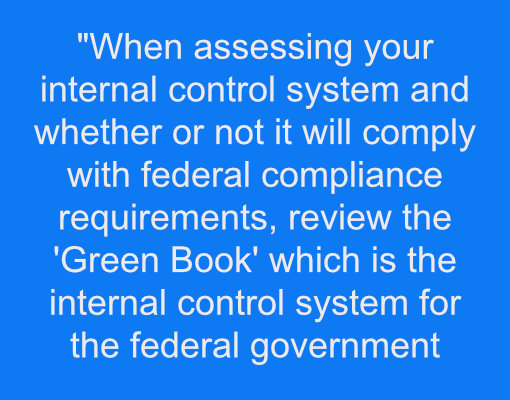Is your local government or nonprofit organization looking for grant awards to assist in a new program or project? The federal government grants monies to many local governments and nonprofits. Many of these grants are given to local governments and nonprofit organizations. If you are expected to receive a federal grant, you may be subject to what’s called the ‘Single Audit’. As a quick background, the single audit was enacted in 1984 and the reason for the single audit was to reduce the audit burden on states, local governments, and nonprofit entities. Recently, the standards changed for federal awards made on or after December 26, 2014. We’ll speak on a few of the new standards to prepare you for this single audit and all its compliance requirements. First and foremost, you will only be required to have a single audit, if you expense $750,000 in cash and noncash outlays like food commodities. Now the single audit is performed in accordance with three levels of auditing standards and requirements:
- Generally accepted auditing standards (GAAS)
- Government auditing standards (GAGAS)
- The requirements of Subpart F of the Uniform Guidance in 2 CFR Part 200.
There are two objectives in the single audit. The first objective is to determine whether the financial statements are presented fairly in accordance with GAAP. The first objective is the same as a financial audit. The second objective is to determine your local government or nonprofit complied with the federal grant agreement. There are also additional reports that need to be prepared. These include the Schedule of Expenditures of Federal Awards, Schedule of Findings, Summary Schedule of Prior Audit Findings, Corrective Action Plan, and other reports depending on the type of federal award. In the following section, we’ll give you recommendations to prepare yourself and your organization for the compliance portion of the single audit as complying with federal compliance requirements can be complex. We’ll endeavor to simplify the process and make the recommendations more generic to more easily understand what your local government or nonprofit needs to do.
DO YOU HAVE AN ADEQUATE INTERNAL CONTROL SYSTEM?
Read the grant agreement and compare its compliance requirements with your organization’s current internal control system. Ask yourself, with our current system, could we document and rely on our current control system will ensure compliance with the grant agreement?
There are 12 general compliance requirements and there should be internal controls working to give the auditor reasonable assurance the system will comply with the 12 requirements. These requirements are:
- Activities allowed / unallowed: Activities charge to a federal grant much be reasonable and conform to any limitations or exclusions in the award. They should also conform to GAAP.
- Allowable costs and cost principles: Costs must be reasonable and conformed to GAAP as well.
- Cash management: You must minimize the time federal funds are held in advanced
- Eligibility: Individuals, groups, or sub-recipients receiving any scholarships, services, etc must be eligible per the grant agreement requirements.
- Equipment and real property management: Equipment must be tracked and inventories.
- Matching, level of effort and earmarking: You may have to contribute your own resources to the program.
- Period of performance: Expenditures can only occur during the specified grant agreement period.
- Procurement and suspension and debarment: Procurement policies must be in writing or a bidding process must be performed and documented.
- Program income: Any program income earned must be retained and used in accordance with the grant agreement.
- Reporting: Each grant agreement may vary in what types of reports are required and when, but it is the organization’s responsibility to prepare and submit the reports per the grant agreement.
- Subrecipient monitoring: The pass-through organization must evaluate the risk of the sub-recipients noncompliance and monitor financial and programmatic progress.
- Special tests and provisions: If there are any other requirements specific to your grant you must comply with these.
INTERNAL CONTROLS OVER COMPLIANCE
When assessing your internal control system and whether it will comply with federal compliance requirements, review the ‘Green Book’ which is the internal control system for the federal government. This system has five components and 17 principles.
The five components with the 17 principles are
- Control environment
- Oversight body and management should demonstrate commitment to integrity and ethical values
- Oversight body should oversee the entity’s internal control system
- Management should establish org structure, assign responsibility, and delegate authority to achieve entity’s objectives
- Risk assessment
- Management should define objectives clearly to enable the identification of risk and define risk tolerances
- Management should identify, analyze, and respond to risks related to achieving the defined objectives
- Management should consider the potential for fraud when identifying, analyzing, and responding to risks
- Management should identify, analyze, and respond to significant changes that could impact the internal control system
- Control activities
- Management should design control activities to achieve objectives and respond to risks
- Management should design the entity’s information system and related control activities to achieve objectives and respond to risks
- Management should implement control activities through policies
- Information & communication
- Management should use quality information to achieve the entity’s objectives
- Management should internally communicate the necessary quality information to achieve the entity’s objectives
- Management should externally communicate the necessary quality information to achieve the entity’s objectives
- Monitoring
- Management should establish and operate monitoring activities to monitor the internal control system and evaluate the results
- Management should remediate identified internal control deficiencies on a timely basis
Make sure your internal control system adequately complies with the 12 compliance requirements and always make sure to document the internal control system. The auditor will be checking for compliance and whether the internal control system is effective. Make sure the whole organization understands and knows the requirements to ascertain operational departments will adhere to the new internal control system or the current one.

FINANCIAL MANAGEMENT SYSTEM
Along with internal controls, you’ll need to assess your financial management system. The federal government mandates the financial management system provide the following:
- Identify federal award income and expenditures and the program(s) under which they were received. Information should include
- Catalog of Federal Domestic Assistance (CFDA) title and number
- Federal award identification number & year
- Federal awarding agency
- Pass-through entity (PTE), if applicable
- Accurate, current, and complete disclosure of the financial results of each federal award or program.
- Records that identify the source and application of funds for federally-funded activities
- Effective control over and accountability for funds, property, and other assets,
- Budget to actual amounts for each federal award
- Written procedures to implement and comply with cash management
- Written procedures for determining the allowability of costs in accordance with cost principles.
Make sure you incorporate your internal control over compliance assessment (found in page 3) with the financial management system as there is an overlap between implementing an internal control system and having your financial management system comply with federal standards.

COOPERATIVE AUDIT RESOLUTION
If there are any findings with the single audit, you will be responsible for following-up and taking corrective action on the findings. The standards recommend taking corrective action should start within six months after the audit report is released. When taking corrective action, your entity must use the cooperative audit resolution mechanisms to improve federal program outcomes through better resolution, follow up, and corrective action. This approach is based on the following:
I. A strong commitment by federal agency and nonfederal entity leadership to program integrity
II. Federal agencies strengthening partnerships and working cooperatively with nonfederal entities and their auditors
II. Focused on current conditions and corrective action going forward
IV. Federal agencies offering appropriate relief for past noncompliance when audits show prompt corrective action
V. Federal agency leadership communicating a clear message that continued failure to correct findings will not be tolerated and will result in sanctions.
FINAL THOUGHTS
To recap, first read the grant agreement. Second, assess your internal control system to see if it complies with the federal standards. Also, check your financial management system if it is up to date and can incorporate all the compliance requirements and prepare the necessary reports. Finally, if after the audit, the auditor finds issues either a lack of internal control system or noncompliance with one of the 12 compliance requirements, you will need to prepare a follow up and corrective plan to resolve the audit findings. Remember you only have six months after the release of the audit to start on your corrective action. Building a strong internal control system and financial management system will give your organization a good firm foundation to comply with the federal requirement and receive an unmodified opinion on compliance with the federal program(s) and/or grant(s).
If you would like to learn more about the single audit and the internal control system for federal governments, please visit the OMB Uniform Guidance website (Single Audit) and the GAO website (Green book) to learn more about this topic.

If you would like to speak with me, I am available. Please email me at david@dfarnsworthcpa.com or call me at (408) 780-2236. Have a great day!
David Farnsworth, CPA
P.S. We are on a mission to help local governments with fraud prevention and governmental finance. We exist to help eliminate abuse, wasteful spending and fraud. Our goal is to help you run a transparent financially responsible District or Agency. When you’re ready, here are a few ways we can help right away:
- Sign-up to our monthly newsletter here. We cover topics ranging from fraud prevention, financial reporting, government budgeting, etc.
- Take our fraud risk assessment (link to assessment here) We’ll give you specific recommendations on how to improve your situation right away.
- Receive our free fraud prevention package (click this link to schedule a meeting)
- Jump on a video conference call to get specific fraud prevention recommendations (click this link to schedule a meeting).
- Request a proposal to perform the financial audit. request for proposal.

